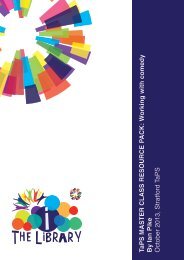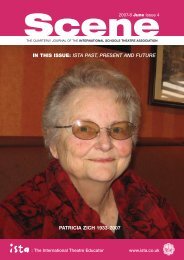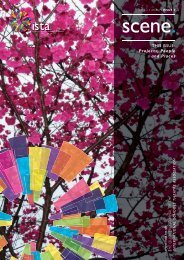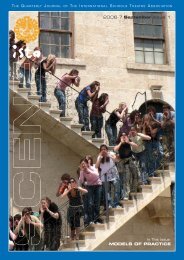ISTA/Scene March 07
ISTA/Scene March 07
ISTA/Scene March 07
You also want an ePaper? Increase the reach of your titles
YUMPU automatically turns print PDFs into web optimized ePapers that Google loves.
instruments including a Duduk on eBay<br />
and learned how to play them for the<br />
show. Other music was provided by<br />
CD’s (there is a lot of Music of the<br />
Middle East available on World Music<br />
CD’s.) Plenty of opportunities for group<br />
dances at weddings and celebrations<br />
and at the end.<br />
Mark Mouck – American School of<br />
Warsaw, Poland<br />
Using David Mamet’s THREE USES<br />
OF THE KNIFE to explore dramatic<br />
structure<br />
After playing theater games for the first<br />
few days of a school year, I have each<br />
of my IB I students lead the ensemble<br />
through a game. Afterwards, they<br />
write about it in their journals in terms<br />
of taking leadership versus playing a<br />
supporting role in the ensemble. This<br />
year one of my students introduced<br />
me to a physical variation of the<br />
telephone game, which I have since<br />
used as a warm up. The idea is that<br />
one student performs an action for the<br />
next student in line, who then repeats<br />
it on down the line with oftenhumorous<br />
results at the end. I have<br />
found that the initiator of the<br />
movement generally wants to tell a<br />
story in mime: a freshmen being<br />
stuffed into a locker; burying a<br />
treasure-box; a frog trying to jump over<br />
a log. By the time the movement gets<br />
to the last person, the story has been<br />
lost. The last person usually flails<br />
about for five seconds and<br />
Calderdale HS<br />
Calderdale HS<br />
16 | <strong>Scene</strong> | 2006-7 <strong>March</strong> Issue 3<br />
then throws their arms up in confusion.<br />
Then fingers are pointed at someone,<br />
usually early in the line, for losing the<br />
story. They want to turn the<br />
destruction of the story into a story,<br />
too, the plot of which is the loss of the<br />
plot. Even in the little games we play,<br />
we need to make up stories.<br />
When devising longer stories with my<br />
students, I emphasize making the story<br />
meaningful to their audience. To explore<br />
the creation of meaning, we explore<br />
dramatic structure. In their sophomore<br />
year, we spend a day looking at the<br />
various incarnations of the hero myth.<br />
The discussion springs from Joseph<br />
Campbell’s The Power of Myth and The<br />
Hero with a Thousand Faces. I warn<br />
them that this discussion may ruin their<br />
movie-going experience as we apply the<br />
structure presented in these books to<br />
Hollywood films. The analysis of<br />
structure generally helps their stories,<br />
but I wanted to go deeper into dramatic<br />
structure with my IB students. After<br />
reading that IB wants students to<br />
engage directly with the writings of<br />
theater practitioners, I bought a number<br />
of ‘primary texts’. David Mamet’s<br />
collection of essays, Three Uses of the<br />
Knife, was among them.<br />
The first line of the first essay is, “It’s in<br />
our nature to dramatize.” That is, we<br />
want to find meaning in everything that<br />
happens to us (and it happens to us.)<br />
Mamet provides a couple of examples<br />
of finding meaning in everyday<br />
experiences. “Great. It’s raining. Just<br />
when I’m blue. Isn’t that just like<br />
life” In another example Mamet goes<br />
on for two pages describing the<br />
perfect ball game. “Do we wish for<br />
our team to take the field and thrash<br />
the opposition from the First<br />
Moment... No. We wish for a closely<br />
fought match that contains many<br />
satisfying reversals.” Ultimately it is just<br />
a sphere (of sorts) moving back and<br />
forth across a field. Ultimately it is just<br />
water condensing in the atmosphere<br />
above us. Ultimately it is just a<br />
movement we are asked to pass down<br />
the line. Just as we find meaning in<br />
phenomena, we find satisfaction in<br />
creating highs and lows in life, what<br />
Mamet summarizes as the “Yes! No!<br />
but Wait!” structure of drama. He<br />
explains, “It is difficult, finally, not to<br />
see our lives as a play with ourselves<br />
the hero.”<br />
When I first gave the third essay in<br />
Mamet’s book to my IB 1 students last<br />
year in preparation for a Shakespeareinspired<br />
devised theater competition, I<br />
thought I was asking them to explore<br />
tragedy. A naturally comedic group, I<br />
wanted to challenge them to<br />
understand the nature and purpose (to<br />
steal Mamet’s phrase) of tragedy. But<br />
as they worked the piece over three<br />
weeks, they realized that comic relief<br />
was necessary for the rhythm and<br />
tempo of the play. As they fitted the<br />
play with the ups and downs they<br />
thought necessary, they realized, and I,<br />
that they weren’t studying just tragedy,<br />
only one of the masks, they were<br />
studying the nature of drama.<br />
The story they created was fun... for a<br />
tragedy. In the end, they decided it<br />
was about what would happen<br />
if Hamlet and Lady Macbeth, unmarried<br />
in their story, were to meet and fall in<br />
love. Somebody is going to cry “Out,<br />
damned spot!” (Hamlet) and somebody<br />
is going to get murdered (Lady<br />
Macbeth.) Story spoiler: Hamlet kills<br />
himself, too. But the beginning of the<br />
process to create the story came from<br />
the title of Mamet’s collection of essays.<br />
In the final essay he quotes the blues<br />
singer Leadbelly, “You take a knife, you<br />
use it to cut the bread, so you’ll have<br />
strength to work; you use it to shave,<br />
so you’ll look nice for you lover; on<br />
discovering her with another, you use it<br />
to cut out her lying heart.” At the<br />
beginning of the process, before they<br />
looked to Shakespeare for inspiration,<br />
before they considered the rhythm of<br />
highs and lows in the play, I asked<br />
them to use an object as a symbol or<br />
image that would, as Mamet suggests,<br />
“subtly change its purpose through the<br />
course of the play.” Like the knife, the<br />
symbol or image should not physically<br />
change, but our perception of it should.<br />
Mamet says, “The tragedy of murder is<br />
affecting as the irony of the recurrent<br />
knife is affecting. The appearance of<br />
the knife is the attempt of the orderly<br />
affronted mind to confront the<br />
awesome.” Like the rain or ball<br />
described above, the knife is neither<br />
good nor evil. Thinking has made it<br />
both. He summarizes the effect of<br />
purposeful dramatic structure here:<br />
In great drama we see this<br />
lesson [the worthlessness of<br />
reason] learned by the hero.<br />
More important, we undergo the<br />
lesson ourselves, as we have<br />
our expectations raised only to<br />
be dashed, as we find that we

















